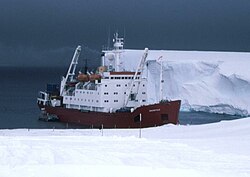Bransfield (ship)
|
||||||||||||||||||
|
||||||||||||||||||
|
||||||||||||||||||
|
||||||||||||||||||
|
||||||||||||||||||
The Bransfield was a ship built in 1970 to supply British Antarctic stations.
history
The ship was designed by Graham & Woolnaugh in Liverpool and built in 1970 under the hull number 508 at the Robb Caledon Shipbuilders shipyard in Leith . The launching of the ship took place on 4 September 1970th The ship was completed at the end of December 1970.
The ship, named after the British navigator and researcher Edward Bransfield , replaced the Shackleton and was mainly used by the British Antarctic Survey to supply the British Antarctic stations - primarily the Halley station . The ship could also be used for research tasks to a limited extent.
On June 28, 1977, the ship represented the Natural Environment Research Council at the Review of the Fleet, which took place in honor of the silver jubilee of Queen Elizabeth II on the part of the Solent between Portsmouth and the Isle of Wight , also known as the Spithead .
The ship made 29 trips to Antarctica , covering a total of almost 900,000 nautical miles . The last Antarctic voyage ended on May 6, 1999. The ship was then sold to the Norwegian shipping company Rieber Shipping. The sale was part of the charter agreement between the British Antarctic Survey and Rieber Shipping for the ship Polar Queen , which was taken over by the British Antarctic Survey to replace the Bransfield for polar research and supply tasks as part of a bareboat charter . The Bransfield was renamed Igenpearl and scrapped in Mumbai in 2000 .
Technical data and equipment
The propulsion of the ship was diesel-electric . Two electric motors that acted on a controllable pitch propeller were available for the propulsion . One of the motors was sufficient for the drive. The ship then reached a cruising speed of just under 11 knots . When using both engines, the ship reached a cruising speed of a good 13 knots. The ship could stay at sea for up to 90 days with one engine and up to 55 days with both engines.
The deck superstructures of the ship were from the midship area to the front. Before and after the superstructure each one were loading space , which are generated by a derrick were served. Later the booms were replaced by cranes . There was a crow's nest in the mast on the superstructure . The hull of the ship was reinforced with ice . There was space for 95 people on board. 37 seats were available for the ship's crew , 58 seats for passengers (researchers and technicians).
Others
The ship was shown several times on postage stamps.
Web links
- RRS Bransfield , British Antarctic Survey
Individual evidence
- ↑ Mike Gloistein: RRS Bransfield - Position Report 31 (Final) , RRS Bransfield - British Antarctic Survey Vessel. Retrieved May 24, 2017.
- ↑ Igenpearl , Maritime-Connector.com. Retrieved May 24, 2017.
- ↑ RRS Bransfield - Yard No 508 ( Memento of 6 February 2013, Internet Archive ), The Loftsman.
- ↑ RRS Bransfield , ShipStamps.co.uk. Retrieved May 24, 2017.
